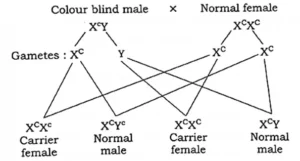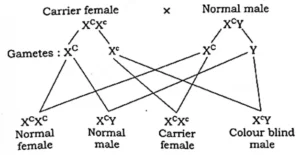Criss-cross inheritance is a pattern where genes are transmitted from father to daughter and then to her son, meaning from male to female and subsequently from female to male (grandson). In simpler terms, it is described as the transfer of genes from a grandfather to his grandson through his daughter.
1) The inheritance pattern of color blindness exhibits a criss-cross pattern. Color blindness, a sex-linked disorder affecting the ability to distinguish between red and green colors, is expressed recessively on the X chromosome and is more commonly seen in males than females.
Genes for normal vision are denoted as XC (dominant), while those for color blindness are represented by Xc (recessive).
In terms of genotypes:
•Normal females carry XCXC.
•Normal males have XCY.
•Color-blind females exhibit XcXc.
•Carrier females possess XCXc.
•Color-blind males carry XcY.
2) Crosses illustrating the transmission of color blindness.
i)A mating between a female with normal vision and a male with color blindness.
 (ii) Crossing a female carrier with a male with normal vision.
(ii) Crossing a female carrier with a male with normal vision.

- A pairing of a normal female with a color-blind male results in an offspring distribution of 50% carrier daughters and 50% normal sons.
- In the case of a carrier female mating with a normal male, the outcome consists of 25% normal daughters, 25% normal sons, 25% carrier daughters, and 25% color-blind sons.
- When a color-blind father passes the disorder to his grandson through his carrier daughter, this pattern of inheritance is referred to as criss-cross inheritance, where traits are transmitted from the father to his grandson through his daughter.